英语入门之时间状语从句(完整)
(完整版)英语状语从句汇总整理版

英语中的九大状语从句状语从句在主从复合句中修饰主句中的动词、形容词或副词等,按意义可以分为时间、地点、原因、目的、结果、条件、方式、比较、让步等状语从句。
一.时间状语从句。
通常由从属连词when, whenever, as, while, before, after, as soon as, till, until, since, once (一旦), hardly……when…, no sooner…….than…; 等引导。
例如:The cyclist started just as the lights changed to green.Whenever we met with difficulties , they cam to help us.He didn’t leave his office until he had finished the day’s work.应注意的问题1.在时间状语从句中,通常要用动词的一般现在时态表示一般将来时态,用一般过去时态表示过去将来时态。
但when 引导一般疑问句或名词性从句时不受上述语法规则的限制,因此,应该加以区分。
例如:When China will enter WTO depends on the bilateral (双边的)joint efforts.Once you understand the rules of the game, you’ll enjoy it.2.when , while, as 的不同用法。
一般说来,当主、从句的动作是同时发生的事,三者可以换用。
when 既可以引导一个持续动作,也可以引导一个短暂动作,可用于主句和从句动作同时发生或从句动作先于主句动作;while 引导的动作必须是持续性的,强调主句和从句的动作同时发生,往往侧重主句和从句动作的对比;as 用于引导“在某行为的继续中发生某事”的“继续之行为”,所以多与过去进行时连用,翻译成“一边……一边……”或者表示动作的变化,翻译成“随着……”。
(完整版)状语从句知识点大全

(完整版)状语从句知识点大全状语从句是一个句子做另一个句子的状语,用于描述、限制、补充或解释主句的动作或状态。
在英语语法中,状语从句非常常见且广泛应用。
以下是状语从句的一些常见知识点:1. 时间状语从句(Time Adverbial Clauses):用来表示时间,常用的引导词有when, while, as, before, after, until, since等。
例如:I will call you when I arrive home.翻译:我到家时会打电话给你。
2. 地点状语从句(Place Adverbial Clauses):用来表示地点,常用的引导词有where, wherever等。
例如:She can't find her keys anywhere.翻译:她无论到哪儿都找不到她的钥匙。
3. 原因状语从句(Cause Adverbial Clauses):用来表示原因,常用的引导词有because, since, as, for等。
例如:I didn't go to the party because I was tired.翻译:因为我累了,所以我没有去参加聚会。
4. 结果状语从句(Result Adverbial Clauses):用来表示结果,常用的引导词有so, therefore, thus等。
例如:He studied hard, so he passed the exam.翻译:他努力研究,所以他通过了考试。
5. 条件状语从句(Condition Adverbial Clauses):用来表示条件,常用的引导词有if, unless, provided that等。
例如:If it rains tomorrow, we won't go to the park.翻译:如果明天下雨,我们不会去公园。
6. 目的状语从句(Purpose Adverbial Clauses):用来表示目的,常用的引导词有so that, in order that等。
时间状语从句(完整版)
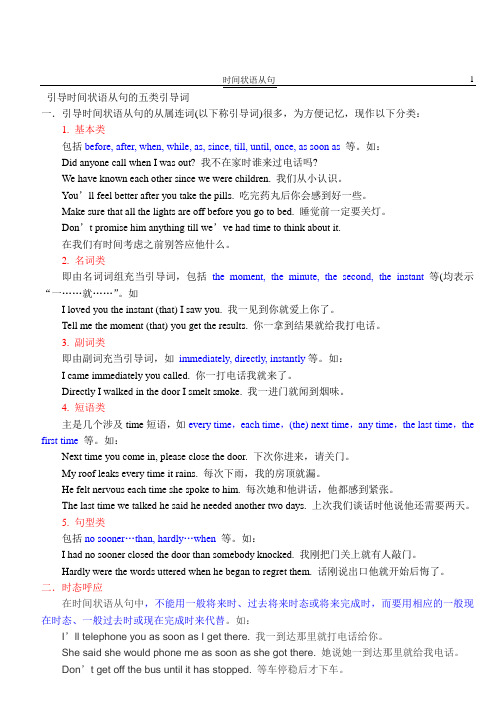
时间状语从句引导时间状语从句的五类引导词一.引导时间状语从句的从属连词(以下称引导词)很多,为方便记忆,现作以下分类:1. 基本类包括before, after, when, while, as, since, till, until, once, as soon as 等。
如:Did anyone call when I was out? 我不在家时谁来过电话吗?We have known each other since we were children. 我们从小认识。
You’ll feel better after you take the pills. 吃完药丸后你会感到好一些。
Make sure that all the lights are off before you go to bed. 睡觉前一定要关灯。
Don’t promise him anything till we’ve had time to think about it.在我们有时间考虑之前别答应他什么。
2. 名词类即由名词词组充当引导词,包括the moment, the minute, the second, the instant 等(均表示“一……就……”。
如I loved you the instant (that) I saw you. 我一见到你就爱上你了。
Tell me the moment (that) you get the results. 你一拿到结果就给我打电话。
3. 副词类即由副词充当引导词,如immediately, directly, instantly等。
如:I came immediately you called. 你一打电话我就来了。
Directly I walked in the door I smelt smoke. 我一进门就闻到烟味。
4. 短语类主是几个涉及time短语,如every time,each time,(the) next time,any time,the last time,the first time 等。
《时间状语从句》课件

在固定搭配中的时间状语从句中,时态的选择非常重要。主句和从句的时态需要保持一致 ,或者根据语境和意义选择适当的时态。
例子
When you arrive at the airport, make sure to check in before the flight leaves. (到 达机场后,请在航班起飞前办理登机手续。)
THANKS
感谢观看
04
时间状语从句的练习与解 析
时间状语从句的简单练习
总结词
基础练习,适合初学者
详细描述
提供一些简单的时间状语从句,如“When I was young, I played football every Sunday.”等,供学生填空或选择正确答案。
时间状语从句的复杂练习
总结词
进阶练习,适合有一定基础的学生
例子
When the clock strikes twelve, I go to bed.(当钟敲响十二点时 ,我上床睡觉。)
时间状语从句的构成
01
02
03
引导词
时间状语从句通常由一些 表示时间的连词引导,如 when、while、before、 after、since等。
时态
时间状语从句中的谓语动 词时态需要根据主句的时 态和时间状语从句的意义 来选择。
时间状语从句中的主被动关系
主动关系
主句和从句的谓语动词都为主动形式,表示主动的动作或状 态。
被动关系
主句和从句的谓语动词都为被动形式,表示被动的动作或状 态。
03
时间状语从句的特殊用法
固定搭配中的时间状语从句
固定搭配
时间状语从句在英语中常与一些固定搭配一起使用,如“when引导的时间状语从句”、 “before引导的时间状语从句”等。这些固定搭配有助于表达时间的先后关系和条件关系 ,使句子更加严谨和准确。
完整版)时间状语从句
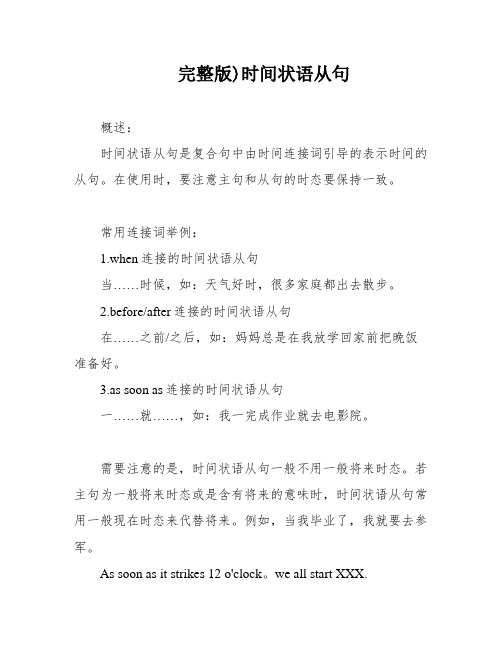
完整版)时间状语从句概述:时间状语从句是复合句中由时间连接词引导的表示时间的从句。
在使用时,要注意主句和从句的时态要保持一致。
常用连接词举例:1.when连接的时间状语从句当……时候,如:天气好时,很多家庭都出去散步。
2.before/after连接的时间状语从句在……之前/之后,如:妈妈总是在我放学回家前把晚饭准备好。
3.as soon as连接的时间状语从句一……就……,如:我一完成作业就去电影院。
需要注意的是,时间状语从句一般不用一般将来时态。
若主句为一般将来时态或是含有将来的意味时,时间状语从句常用一般现在时态来代替将来。
例如,当我毕业了,我就要去参军。
As soon as it strikes 12 o'clock。
we all start XXX.Upon our arrival。
XXX.4.时间状语从句中使用until表示一个动作一直持续到某一时刻,例如:He waited until all the people left。
我们也可以说I didn't go to bed until Mum came back。
表示直到妈妈回家后我才上床睡觉。
5.当while连接时间状语时,表示主句的行为在从句行为过程之中发生。
从句中要使用持续性动词或状态动词,并且持续性动词通常使用进行时态。
例如:While they were waitingfor the New Year。
they listened to music。
sang songs and had fun.Till and until are used to introduce time clauses in affirmative sentences。
with the main clause verb being a continuous n or state that lasts until the time XXX: XXX。
初中英语知识点归纳时间状语从句的引导词和结构
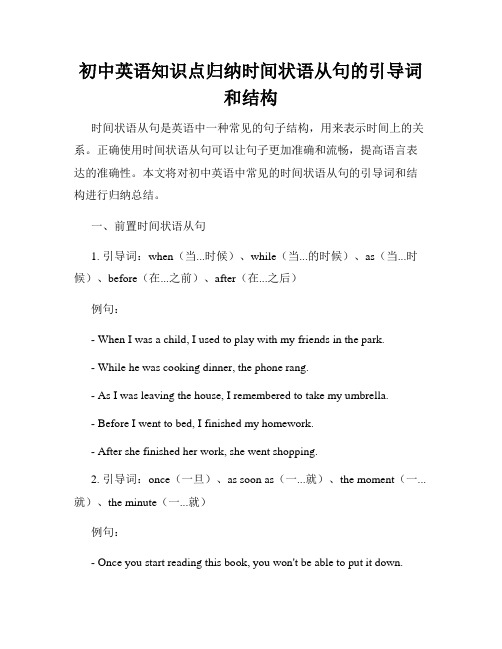
初中英语知识点归纳时间状语从句的引导词和结构时间状语从句是英语中一种常见的句子结构,用来表示时间上的关系。
正确使用时间状语从句可以让句子更加准确和流畅,提高语言表达的准确性。
本文将对初中英语中常见的时间状语从句的引导词和结构进行归纳总结。
一、前置时间状语从句1. 引导词:when(当...时候)、while(当...的时候)、as(当...时候)、before(在...之前)、after(在...之后)例句:- When I was a child, I used to play with my friends in the park.- While he was cooking dinner, the phone rang.- As I was leaving the house, I remembered to take my umbrella.- Before I went to bed, I finished my homework.- After she finished her work, she went shopping.2. 引导词:once(一旦)、as soon as(一...就)、the moment(一...就)、the minute(一...就)例句:- Once you start reading this book, you won't be able to put it down.- As soon as the bell rang, the students rushed out of the classroom.- The moment she saw him, her face lit up with joy.- The minute I arrived at the station, the train left.二、后置时间状语从句1. 引导词:when(当...时候)、while(当...的时候)、before(在...之前)、after(在...之后)、until/till(直到...的时候)、since(自...以来)例句:- I will call you when I arrive at the airport.- She likes to listen to music while she's doing homework.- I went to bed before it started raining.- After she finished her meal, she paid the bill and left.- He didn't speak up until/till the end of the meeting.- Since you have been away, many things have changed.2. 引导词:once(一旦)例句:- You will succeed once you put enough effort into it.三、并列时间状语从句1. 引导词:when(当...时候)、whenever(无论何时)、while (当...的时候)、as(当...时)例句:- You can come to my house when you have time.- Whenever I see a dog, I can't help but smile.- While I was reading a book, my brother was watching TV.- As she was walking in the park, she saw a beautiful flower.2. 引导词:before(在...之前)、after(在...之后)例句:- I will finish my homework before I go out to play.- After she finished her lunch, she went for a walk.以上是初中英语中常见的时间状语从句的引导词和结构的归纳总结。
时间状语从句(初)-英语语法大全
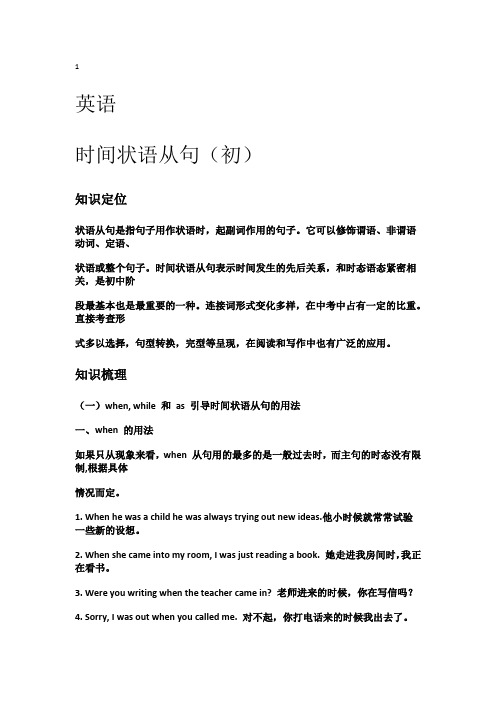
1英语时间状语从句(初)知识定位状语从句是指句子用作状语时,起副词作用的句子。
它可以修饰谓语、非谓语动词、定语、状语或整个句子。
时间状语从句表示时间发生的先后关系,和时态语态紧密相关,是初中阶段最基本也是最重要的一种。
连接词形式变化多样,在中考中占有一定的比重。
直接考查形式多以选择,句型转换,完型等呈现,在阅读和写作中也有广泛的应用。
知识梳理(一)when, while 和as 引导时间状语从句的用法一、when 的用法如果只从现象来看,when 从句用的最多的是一般过去时,而主句的时态没有限制,根据具体情况而定。
1. When he was a child he was always trying out new ideas.他小时候就常常试验一些新的设想。
2. When she came into my room, I was just reading a book. 她走进我房间时,我正在看书。
3. Were you writing when the teacher came in? 老师进来的时候,你在写信吗?4. Sorry, I was out when you called me. 对不起,你打电话来的时候我出去了。
5. He was on the point of leaving when someone knocked at the door. 他正要走,这时有人敲门。
6. I thought of it just when you opened your mouth. 就在你要说话的时候,我也想到了。
7. I had hardly[scarcely] closed my eyes when someone knocked at the door.我刚一闭上眼,就有人在敲门了。
由以上内容可知,when 从句的 A 事件,相当于另一个事件 B 发生的时间点。
也就是说,when 从句的重点不在动作本身发生的状态,而只是把它作为一个时间点,所以when 多数情况下用的是一般过去时,则不用正在进行时。
英语语法讲解之时间状语从句

英语-时间状语从句定义:状语从句是指句子用作状语时,起副词作用的句子。
它可以修饰谓语、非谓语动词、定语、状语或整个句子。
时间状语从句表示时间发生的先后关系。
知识梳理:(一)when,while和as引导时间状语从句的用法一、when的用法如果只从现象来看,when 从句用的最多的是一般过去时,而主句的时态没有限制,根据具体情况而定。
1. When he was a child he was always trying out new ideas.他小时候就常常试验一些新的设想。
2. When she came into my room, I was just reading a book. 她走进我房间时,我正在看书。
3. Were you writing when the teacher came in? 老师进来的时候,你在写信吗?4. Sorry, I was out when you called me. 对不起,你打电话来的时候我出去了。
5. He was on the point of leaving when someone knocked at the door. 他正要走,这时有人敲门。
6. I thought of it just when you opened your mouth. 就在你要说话的时候,我也想到了。
7. I had hardly[scarcely] closed my eyes when someone knocked at the door.我刚一闭上眼,就有人在敲门了。
由以上内容可知,when 从句的A 事件,相当于另一个事件 B 发生的时间点。
也就是说,when 从句的重点不在动作本身发生的状态,而只是把它作为一个时间点,所以when 多数情况下用的是一般过去时,则不用正在进行时。
因为如果用正在进行时,它表示的就是一段时间而不是一个时间点了。
实际上,when 从句也可以有其它的时态,但几乎也不用进行时,因为它也只是作为一个时间参照点。
时间状语从句ppt课件

详细描述
过去完成时态用于描述过去的某个动作发生在另一个过去的动作之前,例如“He said he had finished his work before leaving the office.”(他说他在离开办公室之前已 经完成了工作。)和“When I arrived, she had already left.”(当我到达时,她已
经离开了。)
04
CHAPTER
时间状语从句的注意事项
主句与从句时态要一致
总结词
在时间状语从句中,主句和从句的时态 必须保持一致,以正确表达时间关系。
VS
详细描述
时间状语从句通常表示某个动作发生的时 间或与时间相关的条件,因此主句和从句 的时态必须匹配,以准确表达事件发生的 先后顺序。例如,“当她走进房间时,他 正在看书”中,“走进房间”发生在“正 在看书”之前,因此主句和从句都使用了 过去进行时。
05
CHAPTER
时间状语从句的练习与解析
练习题一解析
总结词
简单时间状语从句
详细描述
这道练习题考察的是简单时间状 语从句的用法,如“when”、 “before”、“after”等,从句 中的时态与主句保持一致。
练习题二解析
总结词
复杂时间状语从句
详细描述
这道练习题涉及的是复杂时间状语从 句,如“not…until”、“as soon as”等,从句中的时态与主句保持一 致,同时要注意从句中时态的先后顺 序。
after的用法
After表示在某个时间点之后,引导时 间状语从句。
例如:After the movie ended, we went for a snack.
(完整版)高中时间状语从句语法及练习

(完整版)高中时间状语从句语法及练习时间状语从句是一个复合句结构,用来表示时间关系。
在高中英语研究中,时间状语从句是一个重要的语法点。
本文将为你详细介绍高中时间状语从句的语法规则,并提供一些练题目。
一、时间状语从句的定义和用法时间状语从句是用来表示时间关系的从句,它可以在句子中充当状语。
时间状语从句通常使用连词来引导,常见的引导词有:when, while, before, after, as, since, until, etc. 时间状语从句可以出现在主句的前面或后面。
二、时间状语从句的语法规则1. 当主句的谓语动词表示将来时,时间状语从句中的谓语动词可以使用一般现在时代替一般将来时。
例:I will call you when I arrive home.(主句使用了将来时,从句中使用了一般现在时)2. 当主句的谓语动词表示过去时,时间状语从句中的谓语动词可以使用一般过去时或过去完成时代替。
例:She had finished her homework before she went to bed.(主句使用了过去时,从句中使用了过去完成时)3. 当时间状语从句表示一个惯性的动作或一个客观事实时,从句中的谓语动词可以使用一般现在时。
例:I always go for a walk when it is sunny.(从句中表示惯性的动作)三、时间状语从句的练题目1. 选择正确的连词填空:― She fell asleep _______ she finished her book.1) while 2) because 3) after― We will start the meeting _______ everyone ar rives.1) before 2) since 3) until2. 改写句子,将主句的谓语动词改为表示将来时:― I will call you when I have time.3. 改写句子,将主句的谓语动词改为表示过去时或过去完成时:― He went to bed before he finished his work.以上是关于高中时间状语从句的语法规则及练习题目的详细介绍。
完整版)状语从句(9种全)

完整版)状语从句(9种全)状语从句在复合句中起到修饰主句的作用,分为时间、地点、原因、目的、结果、条件、方式、比较、让步等种类。
1.时间状语从句时间状语从句的连接词包括when。
as。
while。
after。
before。
since。
ever since。
as soon as。
once。
till。
until。
whenever。
no sooner…than。
hardly/scarcely。
when。
the moment/minute/instant/second。
every time。
each time。
any time。
the first time。
next time。
last time。
all the time。
by the time。
directly。
immediately。
instantly等。
例如,“一···就···”的句型可以用as soon as或once引导,其中as soon as侧重时间或动作先后衔接紧,而once侧重条件,表示“一旦。
”;on doing sth/on one's + n.作时间状语,例如On arriving at the n。
the thief was arrested.意为“一到达车站,这个小偷就被逮捕了。
”2.地点状语从句地点状语从句的连接词包括where。
wherever。
anywhere。
everywhere等。
例如,I'll go wherever you go.意为“你去哪儿,我就跟你去哪儿。
”3.原因状语从句原因状语从句的连接词包括because。
since。
as。
now that。
seeing that。
considering that等。
例如,Since it's raining。
we'll stay indoors.意为“因为下雨,我们将待在室内。
时间状语从句

②在下列情况下,三者彼此之间不能替换使用: a.as更强调同一时间或紧接的一前一后或伴随着的变化。
eg. We listened to the singer sing as he played the guitar. 我们听着歌星边弹吉它边演唱。
I thought of it just as you opened your mouth. 你一张嘴我就知道你要说什幺
时间状语从句
引导时间状语从句的普通类从属连 词有when(当……时),while (在……期间),as(当……,一 边……一边……),before(在……之 前),after(在……之后),since (从……以来),till/until(直到), whenever(无论何时),as soon as (一……就)等。
③as表示随着
eg. As time goes on, it's getting warmer and warmer. 随着时间的推移,天气变得越来越暖了。
时间状语从句
when, while, as的用法区别
①只有当从句表示的是段时间,即其谓语动词有持续性特征时,这三者可 以通用互换。 eg. I got the news on the radio when while as I was having breakfast. 我在吃早饭的时候从收音机里获悉这一消息。
I saw Jim as when he left the meeting room. 吉姆离开会议室时候我看到了他。
时间状语从句ppt课件

时间状语从句的省略
省略主语和助动词
当从句的主语和助动词与主句的主语一致时,从 句的主语和助动词可以省略。
省略be动词
当从句中的动词是be动词时,be动词可以省略。
省略连词
当从句和主句之间没有连词连接时,连词可以省 略。
时间状语从句的倒装
倒装句式
时间状语从句中的主语和动词的顺序可以颠倒,形成倒装句式。
总结词
表示一个动作从过去某时开始一直持续 到现在
VS
详细描述
Since通常用于描述一个从过去某时开始 一直持续到现在的动作或状态。例如: “I have been waiting since 9 o'clock.”(我从9点钟就开始等了。)
03
CATALOGUE
时间状语从句的时态搭配
现在时与过去时的搭配
时态
时间状语从句的时态要与 主句的时态相呼应,一般 遵循“主将从现”的原则 。
语序
时间状语从句通常是陈述 语序。
时间状语从句的作用与重要性
作用
时间状语从句可以用来描述动作发生的时间、持续时间或动作的先后顺序,从 而使句子更加准确和清晰。
重要性
在英语语法和写作中,正确使用时间状语从句对于表达时间关系和增强文章逻 辑性非常重要。掌握时间状语从句的构成要素和运用技巧有助于提高英语水平 和写作能力。
主句的意义和语气对时间状语从句的意义和语气有影响。例如,如果主 句是疑问句,那么时间状语从句也可能需要使用疑问语气。
主句中的特定词汇或结构可以与时间状语从句形成对照或对比,从而强 调某些信息。
06
CATALOGUE
时间状语从句的常见错误分析
混淆不同类型的时间状语从句
01
一般现在时态的时间状语从句
初中英语语法大全——状语从句(共24张PPT)

Kathy is so lovely that we all like to play with her.
He made so many mistakes that he failed the exam once again.
Such a little boy has so little difficulty in working out this problem that I admire him very much.
3、since的用法
(1) since意为“自从....”, 主句常用现在完成时或般现在时 , 从句常用一般过去时。 eg: I have lived in England since I was three. 自3岁起 我就一直住在英国。 eg: It is two years since I became a college student. 我成为一名大学生已经两年了。
二、地点状语从句
在句子中充当地点状语的从句称为地点状语从句。引 导地点状语从句的从属连词主要有where( ...地 方), wherever(无论问处)等,表示地点方位。 eg: I found all the missing things where I left t hem. eg: Where there is a will, there is a way.
2. such...that...的用法
在such... that... 结构中,such是形容词,修饰名词或名词短语。引导 结果状语从句时,常用于以下结构:
a(n)+形容词+单数可数名词
so+ such+ 形容词+复数可数名词
+that+从句
(完整版)时间状语从句(全面掌握)
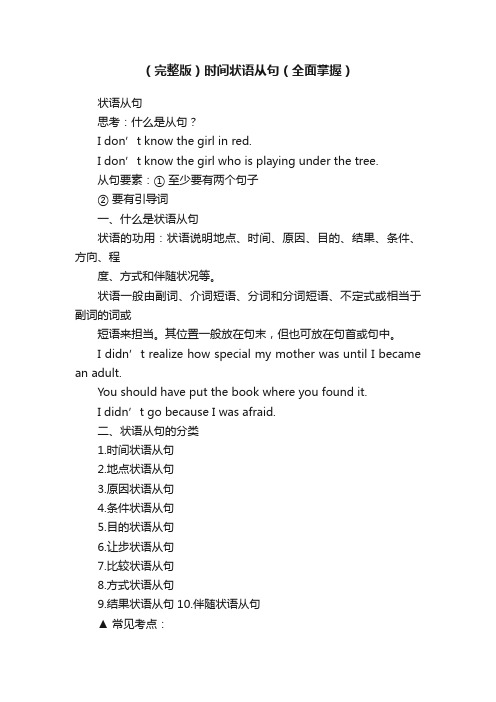
(完整版)时间状语从句(全面掌握)状语从句思考:什么是从句?I don’t know the girl in red.I don’t know the girl who is playing under the tree.从句要素:① 至少要有两个句子② 要有引导词一、什么是状语从句状语的功用:状语说明地点、时间、原因、目的、结果、条件、方向、程度、方式和伴随状况等。
状语一般由副词、介词短语、分词和分词短语、不定式或相当于副词的词或短语来担当。
其位置一般放在句末,但也可放在句首或句中。
I didn’t realize how special my mother was until I became an adult.You should have put the book where you found it.I didn’t go because I was afraid.二、状语从句的分类1.时间状语从句2.地点状语从句3.原因状语从句4.条件状语从句5.目的状语从句6.让步状语从句7.比较状语从句8.方式状语从句9.结果状语从句10.伴随状语从句▲ 常见考点:考点一、主句与从句的时态呼应问题;考点二、连接词的选择。
考点三、状语从句与非谓语动词之间的替换;考点四、根据从句与主句的逻辑关系选用从属连词;3、时间状语从句详解1.引导词(1)基本类:before ,after ,when ,while ,as ,since ,till ,until ,once ,as soon as.(2)名词类:(由名词词组充当引导词)the moment ,the minute ,the second ,the instant ,(一…就…) every time ,each time ,the first time ,the last time(3)副词类:(由副词充当引导词)immediately ,directly ,instantly (一…就…)(4)句型类:no sooner…than… ,hardly/scarcely…when…(一…就…)2.引导词具体讲解:当…时候:It was s ix o’clock when I got home.Sb was doing sth when…1)when 这时Sb was about to do sth/was on the point of doing sth when…Sb had just done sth when…既然: It was foolish of you to take a taxi when you could walk there in five minutes.既然你能5分钟就走到那儿,再搭出租车真是太傻了。
英语句型分析之状语从句(完整版)
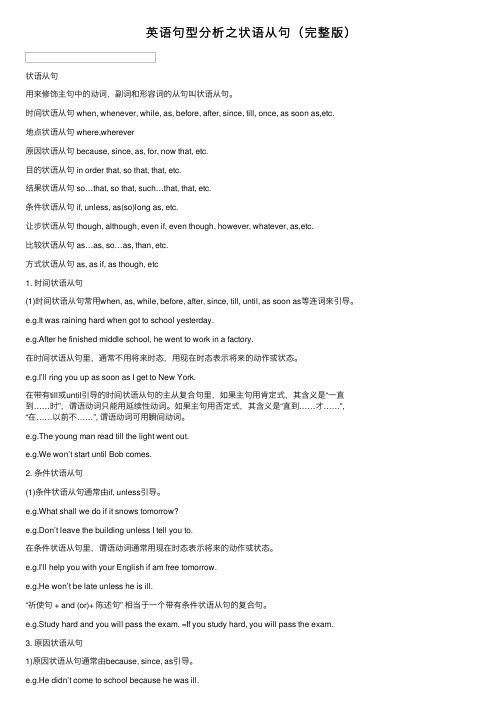
英语句型分析之状语从句(完整版)状语从句⽤来修饰主句中的动词,副词和形容词的从句叫状语从句。
时间状语从句 when, whenever, while, as, before, after, since, till, once, as soon as,etc.地点状语从句 where,wherever原因状语从句 because, since, as, for, now that, etc.⽬的状语从句 in order that, so that, that, etc.结果状语从句 so…that, so that, such…that, that, etc.条件状语从句 if, unless, as(so)long as, etc.让步状语从句 though, although, even if, even though, however, whatever, as,etc.⽐较状语从句 as…as, so…as, than, etc.⽅式状语从句 as, as if, as though, etc1. 时间状语从句(1)时间状语从句常⽤when, as, while, before, after, since, till, until, as soon as等连词来引导。
e.g.It was raining hard when got to school yesterday.e.g.After he finished middle school, he went to work in a factory.在时间状语从句⾥,通常不⽤将来时态,⽤现在时态表⽰将来的动作或状态。
e.g.I’ll ring you up as soon as I get to New York.在带有till或until引导的时间状语从句的主从复合句⾥,如果主句⽤肯定式,其含义是“⼀直到……时”,谓语动词只能⽤延续性动词。
- 1、下载文档前请自行甄别文档内容的完整性,平台不提供额外的编辑、内容补充、找答案等附加服务。
- 2、"仅部分预览"的文档,不可在线预览部分如存在完整性等问题,可反馈申请退款(可完整预览的文档不适用该条件!)。
- 3、如文档侵犯您的权益,请联系客服反馈,我们会尽快为您处理(人工客服工作时间:9:00-18:30)。
[编辑本段]简介(adverbial clause of time)概念:在复合句中,由时间连接词引导的状语从句叫做时间状语从句。
(在复合句中,要注意主句和从句的时态大多都要保持一致。
)时间状语从句1.由when, while, as,after,before,since,untill,引导的时间状语从句。
例如:When you think you know nothing, then you begin to know something.当你以为自己一无所知的时候,你就是在开始知道一些事物了。
When truth is buried under the ground it grows, it chokes, it gathers su ch an explosive force that on the day it bursts out , it blows up everything with it.当真理被埋在地下的时候,它在生长,它感到压抑,它蓄存着这么一种爆炸性力量,一旦冒出,它就会炸破一切!Strike while the iron is hot. 趁热打铁。
You can feel the air moving as your hand pushes through it. 当你的手在空气中挥动的时候,你就能感觉到空气在流动。
Our headmaster laughed as she spoke.我们的校长边谈边笑。
主要时态:主过从过;主将从现;主句为一般现在时,从句不受影响。
[编辑本段]区别when, while和as的区别:when引导的从句的谓语动词可以是延续性的动词,又可以是瞬时动词。
并且when有时表示“就在那时”。
例如:时间状语从句When she came in, I stopped eating.她进来时,我停止吃饭。
(瞬时动词) When I lived in the countryside, I used to carry some water for him.当我住在农村时,我常常为他担水。
(延续性的动词)We were about to leave when he came in.我们就要离开,就在那时他进来了。
While引导的从句的谓语动作必须是延续性的,并强调主句和从句的动作同时发生(或者相对应)。
并且while有时还可以表示对比。
例如:While my wife was reading the newspaper, I was watching TV. (was re ading是延续性的动词,was reading和was watching同时发生)I like playing football while you like playing basketball.我喜欢踢足球,而你喜欢打篮球。
(对比)As表示“一边……一边”,as引导的动作是延续性的动作,一般用于主句和从句动作同时发生;as也可以强调“一先一后。
例如:We always sing as we walk.我们总是边走边唱。
(as表示“一边……一边”)As we was going out, it began to snow.当我们出门时,开始下雪了。
(as 强调句中两个动作紧接着先后发生,而不强调开始下雪的特定时间)2.由before和after引导的时间状语从句。
注意before引导的从句不再用否定式的谓语,并且当before引导的从句位于主句之后,有时译成“就,才”。
还要注意主句和从句之间的时间关系。
当主句用将来时,从句总是用现在时;如果before引导的主句谓语用的是过去时,则从句动词多用过去完成时,这样以便体现动作发生的先后。
After表示主句动作发生在从句动作之后。
主句和时间状语从句从句的动作的时间关系正好与before引导的从句相反。
例如:It will be four days before they come back. 他们要过四天才能回来。
Einstein almost knocked me down before he saw me.爱因斯坦几乎把我撞倒才看到我。
My father had left for Canada just before the letter arrived.我父亲恰好在信到之前去加拿大了。
They had not been married four months before they were divorced. 他们结婚还不到四个月就离婚了。
After you think it over, please let me know what you decide.你仔细考虑过以后,告诉我你是怎样决定的。
After we had finished the work, we went home.完成工作之后,我们回家了。
(从句用过去完成时,主句用一般过去时)3.由till或until引导的时间状语从句。
till和until一般情况下两者可以互换,但是在强调句型中多用until。
并且要注意的是:如果主句中的谓语动词是瞬时动词时,必须用否定形式;如果主句中的谓语动词是延续性动词时,用肯定或否定形式都可以,但表达的意思不同。
till不可以用在句首,而until可以放在句首。
例如:I didn't go to bed until(till)my father came back.直到我父亲回来我才上床睡觉。
It was not until the meeting was over that he began to teach me Englis时间状语从句h.直到散会之后他才开始教我英语。
I worked until he came back.我工作到他回来为止。
I didn't work until he came back.他回来我这才开始工作。
Please wait until I arrived.在我到达之前请等我。
4.由since引导的时间状语从句。
since引导的从句的谓语动词可以是延续性的动词,又可以是瞬时动词。
一般情况下,从句谓语动词用一般过去时,而主句的谓语动词用现在完成时。
但在It is +时间+since从句的句型中,主句多用一般现在时。
例如:I have been in Beijing since you left. 自从你离开以来,我一直在北京了。
Where have you been since I last saw you? 自上次我和你见面以后,你到哪里去了?It is four years since my sister lived in Beijing. 我妹妹不在北京住有四年了。
It is five months since our boss was in Beijing.我们老板离开北京有五个月了。
5.由as soon as, immediately, directly, instantly, the moment, the instant, the minute, 等引导的时间状语从句。
这些连词都表示“一……就”。
例如:I will go there directly I have finished my breakfast. 吃完早饭,我立即到那里去。
The moment I heard the news, I hastened to the spot.我一听到消息,马上赶到了出事地点。
As soon as I reach Canada, I will ring you up. 我一到加拿大,就给你来电话。
[编辑本段]注意hardly(scarcely, rarely)…when / before, no sooner…than相当于as soon a s之意。
主句用过去完成时,从句用一般过去时。
当hardly, scarcely, rarely和no sooner位于句首时,时间状语从句主句应用倒装语序。
例如:He had no sooner arrived home than he was asked to start on another journey. 他刚到家,就被邀请开始另一旅程。
No sooner had the sun shown itself above the horizon than he got out of bed to commence work.太阳刚从地平线上升起,他就起床劳动去了。
Hardly had I sat down when he stepped in.我刚坐下,他就进来了。
He had hardly fallen asleep when he felt a soft touch on his shoulder.这个阿拉伯人刚要入睡就感到肩膀上被轻轻一触。
6.由by the time引导的时间状语从句。
注意时态的变化:在一般情况下,如果从句的谓语动词用一般过去时,主句的谓语动词用过去完成时;如果从句的谓语动词用一般现在时,主句的谓语动词用将来完成时。
例如:By the time you came back, I had finished this book.到你回来时,我已经写完这本书了。
By the time you come here tomorrow, I will have finished this work. 你明天来这儿的时候,我将已经完成此工作了。
7.由each time, every time和whenever引导的时间状语从句。
例如:Each time he came to Harbin, he would call on me. 他每次来哈尔滨,总是来看我时间状语从句。
Whenever that man says“To tell the truth”, I suspect that he's about to tell a lie.每当那个人说“说实在话”的时候,我猜想他就要说谎了。
You grow younger every time I see you. 每次遇到你,见你更年轻了。
8.由as long as和so long as引导的时间状语从句。
这两个连词表示“只要“例如:You can go where you like as long as you get back before dark. 你可以随意到哪里去,只要在天黑以前回来就行。
I will fight against these conditions as long as there is a breath in my body! 只要我一息尚存,我就要反对这种境况。
